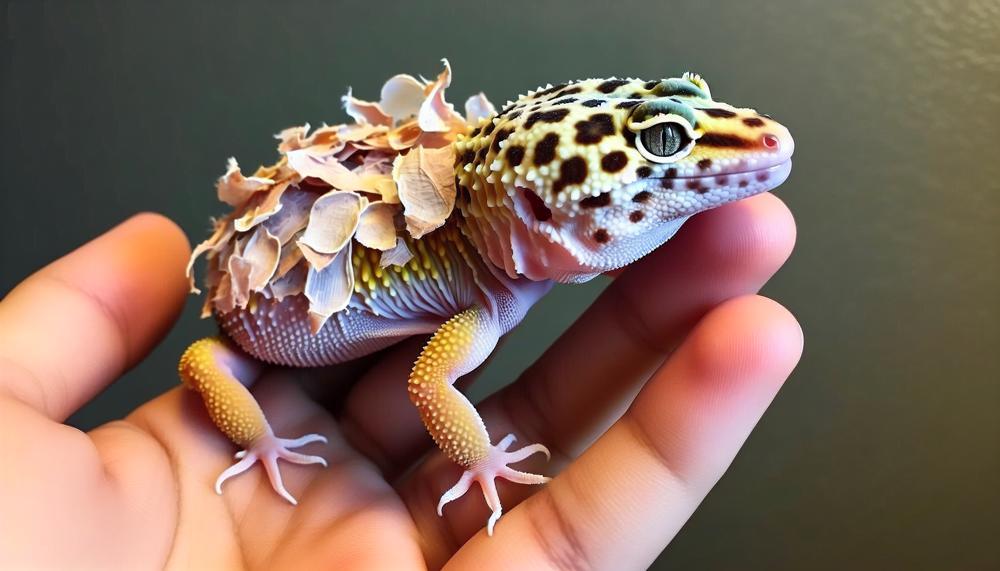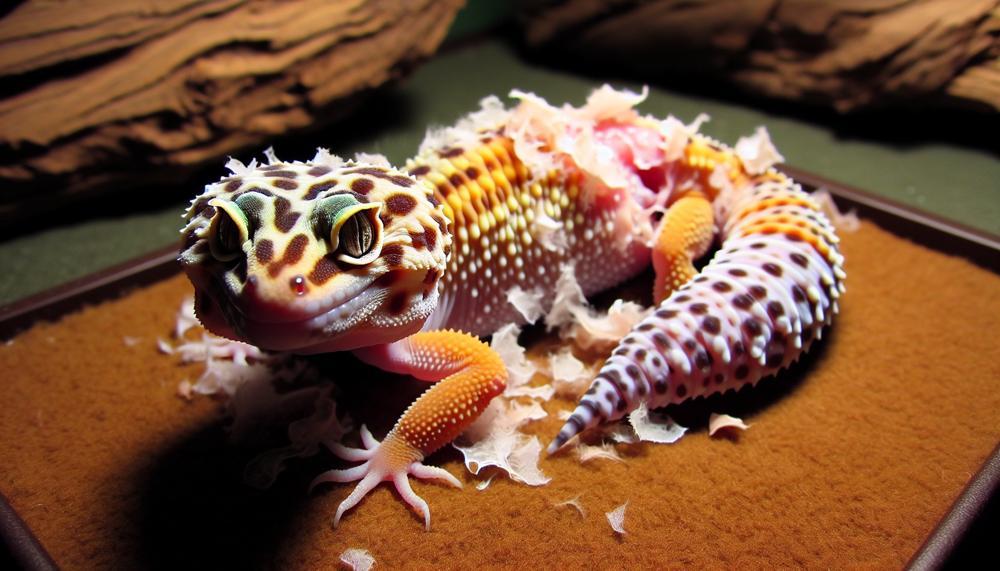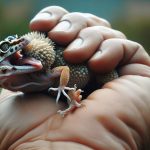Are you the proud parent of a leopard gecko? Or perhaps you’re considering adopting one into your family?
Either way, understanding their shedding habits is crucial for their health and well-being. These charming creatures have fascinating and sometimes concerning shedding patterns. The patterns are unique to them.
In this blog post, we’ll take a deep dive into the world of leopard geckos’ shedding habits. From why they shed to how to help them through the process, we’ve got you covered.
Prepare to be amazed by these incredible creatures as we explore their shedding journey in our comprehensive guide.
- What is the reason behind leopard geckos’ shedding?
- How frequently do they shed?
- What are the tell-tale signs of an upcoming shed?
- What can you do to support your gecko during the shedding process?
- Common issues with shedding and how to address them
- Fun facts about the intriguing process of leopard geckos’ shedding
Whether you’re an experienced gecko owner or new to the world of reptiles, this post will offer valuable insights on the unique shedding habits of leopard geckos.
So, let’s get started on uncovering all there is to know about these amazing creatures.
Contents
- 1 How Often Should A Leopard Gecko Shed?
- 2 How Long Does It Take For A Leopard Gecko To Finish Shedding?
- 3 Should I Feed My Leopard Gecko While It’s Shedding?
- 4 Should I Handle My Leopard Gecko When Shedding?
- 5 Can Leopard Geckos Die From Shedding?
- 6 Why Is My Leopard Gecko Constantly Shedding?
- 7 Tips To Help A Leopard Gecko Shed
- 8 Conclusion
How Often Should A Leopard Gecko Shed?
Leopard geckos typically shed their skin every 4-8 weeks, although younger geckos may shed more frequently due to their rapid growth rate.
This shedding process usually takes 24-48 hours, during which the gecko may consume its old skin. However, there are various factors that can affect the shedding frequency of leopard geckos.
Age and Physical Condition:
Younger geckos may shed more frequently than adults due to their faster growth rate.
Additionally, physical conditions like pregnancy or recent injuries can also impact the shedding frequency.
Humidity Levels:
Maintaining a humidity level of 20-40% is crucial for proper shedding in leopard geckos.
If the humidity levels are too low, the skin may become dry and difficult to shed. Conversely, high humidity levels can lead to skin infections and other health issues.
Diet:
A balanced diet is essential for maintaining healthy skin in leopard geckos. Poor nutrition can result in dryness and flakiness, making shedding more challenging for these reptiles.
Environment:
The environment, including temperature and lighting, can also affect the shedding frequency of leopard geckos.
Burns from heat lamps or excessively high temperatures can cause excessive shedding.
Providing appropriate hiding spaces and temperature gradients can help regulate the shedding process.
Stress:
Stressful situations, such as frequent handling or competition with aggressive geckos, can also contribute to abnormal shedding in leopard geckos.
Underlying Health Issues:
If a leopard gecko is shedding more frequently than normal, it could be a sign of underlying health issues like parasites or dehydration.
How Long Does It Take For A Leopard Gecko To Finish Shedding?
The process of shedding for a leopard gecko typically takes between 24-48 hours, but this can vary depending on various factors such as age, health, and environment.
In certain cases, it may take up to a full day for the leopard gecko to finish shedding.
Factors That Influence Shedding Time:
| Factor | Average Time | Range |
| Age | Young geckos typically shed every 1-2 weeks | Adult geckos tend to shed every 4-8 weeks |
| Health | No significant impact on shedding time | N/A |
| Humidity | A dry environment can delay the shedding process | N/A |
| Diet | A proper diet with enough calcium and vitamins can promote healthy shedding | N/A |
| Environment | Poor living conditions can cause stress and delay the shedding process | N/A |
| Stress | High levels of stress can prolong the shedding process | N/A |
Other Factors That May Affect Shedding Time:
|
||
| It is crucial for owners to closely monitor their leopard gecko’s shedding process and make necessary adjustments to their care routine. This can include ensuring proper humidity levels, providing a nutritious diet, and creating a stress-free environment. If a leopard gecko shows prolonged shedding times or other concerning symptoms, it is best to consult a veterinarian for proper diagnosis and treatment. | ||
Should I Feed My Leopard Gecko While It’s Shedding?
When your leopard gecko is shedding, it is best to avoid feeding them. As mentioned in the previous section, this process usually takes 24-48 hours and during this time, they may eat less or not eat at all.
To prevent any potential health issues, it is important to remove any uneaten food from their enclosure. Instead, focus on providing a clean and comfortable environment for your gecko.

| Day | Feeding Schedule | Notes |
| Day 1 | Avoid feeding during shedding process | Eating is not recommended during the shedding process as it may lead to health problems. |
| Day 2 | Avoid feeding during shedding process | Eating is not recommended during the shedding process as it may lead to health problems. |
| Day 3 | Resume regular feeding schedule | After the shedding process is complete, resume your leopard gecko’s regular feeding schedule (every 2-3 days). |
It is important to keep in mind that each gecko may behave differently during shedding. While some may still show interest in food, others may completely avoid eating. If your gecko continues to show disinterest in food after shedding, it is advisable to consult a veterinarian to rule out any underlying health issues.
Furthermore, it is crucial to provide a balanced and nutritious diet for your leopard gecko even when they are not actively eating during shedding. This includes a variety of live insects such as crickets, mealworms, and dubia roaches, as well as calcium and vitamin supplements.
Should I Handle My Leopard Gecko When Shedding?
The answer is no. During this time, they may become irritable and handling them can disturb their shedding process. It is best to wait until after they have shed completely before handling them again.
Why is it not recommended to handle your leopard gecko while they are shedding?
Leopard geckos require a specific environment and care in order to successfully shed their skin. Any interference during this process can cause issues such as incomplete shedding or retained skin. This can lead to health problems for your gecko and may require a visit to the veterinarian.
Handling your leopard gecko while they are shedding can cause stress and discomfort for them. This may result in defensive or aggressive behavior, potentially causing harm to both you and your pet.
How can you ensure a smooth shedding process for your leopard gecko?
The best way to help your leopard gecko during shedding is by providing a suitable environment that promotes healthy shedding. This includes maintaining proper humidity levels and providing a moist hide for your gecko to retreat to. A shallow soaking dish can also be helpful in aiding the shedding process.
Additionally, it is important to avoid feeding your leopard gecko during this time as they may not have an appetite and could potentially choke on food due to their loose skin. Wait until after they have shed completely before resuming their regular feeding schedule.
Can Leopard Geckos Die From Shedding?
Shedding is a natural and necessary process for leopard geckos, but it can also come with potential risks and dangers. As pet owners, it is crucial to be aware of these potential hazards in order to ensure your gecko safely sheds without any harm. Some of the potential risks and dangers of shedding for leopard geckos include:
- Retained Skin: Occasionally, geckos may struggle to shed their skin completely, leaving behind remnants in sensitive areas such as the eyes, toes, vent, or tail tip. This can cause discomfort, pain, and even infection if not properly removed.
- Dehydration: During shedding, geckos require proper hydration to help loosen their old skin and facilitate the shedding process. If they become dehydrated, the skin can become dry and difficult to shed, which can lead to retained skin or even suffocation if it becomes stuck on the gecko’s face.
- External Parasites: Shedding can make geckos more susceptible to external parasites like mites or ticks, which can cause irritation and harm to their skin.
- Stress: Handling or other sources of stress during the shedding process can also cause difficulties for geckos. Stress can delay shedding or even lead to the gecko eating its own skin, resulting in potential health problems.
To ensure your gecko sheds safely without any harm, here are some tips for pet owners to follow:
- Provide Proper Hydration: Always make sure your gecko has access to a water bowl and regularly mist their habitat to maintain appropriate humidity levels.
- Limit Handling: During the shedding process, try not to handle your gecko as this can cause stress and delay shedding.
- Manage Stressors: Ensure that your gecko’s habitat is correctly set up and free from potential stressors such as loud noises or bright lights.
- Seek Veterinary Assistance: If your gecko is struggling to shed or has retained skin in sensitive areas, it is best to seek veterinary assistance to safely remove the skin without causing harm to your gecko.
Why Is My Leopard Gecko Constantly Shedding?
Determining if your leopard gecko’s shedding frequency is normal requires careful tracking of when they shed and how long the process takes. Adult geckos typically shed every 4-6 weeks, while juveniles shed every 2-3 weeks. The entire shedding process should not exceed 7-10 days. However, if your gecko sheds more frequently or takes much longer to shed, it could be a sign of an underlying health issue.
Abnormal shedding patterns in leopard geckos can have various causes, including stress, malnutrition, and parasites. Stress can arise from improper handling, inadequate diet, or an unsuitable living environment.
It is crucial to address these issues to improve your gecko’s shedding frequency. Malnutrition can also affect shedding, so make sure your gecko is getting a balanced diet and proper nutrition.
In some cases, parasites like nematodes or coccidia may cause abnormal shedding patterns, so seek veterinary assistance if you suspect your gecko may have parasites.
Monitoring your leopard gecko’s shedding frequency is essential for their health and well-being. By knowing what is considered normal and being aware of potential causes of abnormal shedding, you can provide the best care for your pet. Always consult a reptile veterinarian for any concerns about your gecko’s shedding or overall health.
| Normal Shedding Frequency | Adults: Every 4-6 weeks | Juveniles: Every 2-3 weeks | Track when they shed and how long it takes (no longer than 7-10 days) |
| Possible Causes of Abnormal Shedding | Stress, malnutrition, parasites | Monitor for excessive or frequent shedding | |
| Treatment for Abnormal Shedding | Address underlying issues, ensure proper diet and nutrition, seek veterinary assistance if necessary | Consult with a reptile veterinarian for any concerns |
To determine if your leopard gecko’s shedding is normal, it is important to keep track of when they shed and the duration of the process. Adult geckos typically shed every 4-6 weeks, while juveniles shed every 2-3 weeks. The entire shedding process should not exceed 7-10 days. However, if your gecko sheds more frequently or takes much longer to shed, it could be a sign of an underlying health issue.
Stress, malnutrition, and parasites are common causes of abnormal shedding patterns in leopard geckos.
Stress can be caused by improper handling, an inadequate diet, or an unsuitable living environment. It is crucial to address these issues to improve your gecko’s shedding frequency.
Tips To Help A Leopard Gecko Shed
To help you ensure a successful shedding process for your pet, here are some tips and techniques that you can use:
- Provide a humid hide: It is crucial to create a humid environment for leopard geckos during shedding. You can achieve this by using damp moss or paper towels to create a humid hide. This will provide the necessary moisture for your gecko to shed properly.
- Spray or mist regularly: Along with a humid hide, you can also spray or mist your gecko’s cage regularly to maintain humidity levels. This will prevent the skin from drying out and getting stuck during shedding.
- Soak in lukewarm water: If your gecko is having trouble shedding, gently soaking them in lukewarm, shallow water for 10-15 minutes can help. This will soften the skin and make it easier for them to shed.
- Gently rub excess skin: Using a damp Q-tip or cotton ball, gently rubbing the excess skin on your gecko’s body can help loosen it and make shedding easier.
- Use commercial products: There are commercial reptile sprays and shedding aid products available that can help with the shedding process. However, use these products cautiously and follow the instructions carefully.
- Seek veterinary care: If at-home remedies are not working, it may be best to take your leopard gecko to a veterinarian who specializes in reptiles. They can provide professional care and advice to ensure successful shedding.
- Do not peel off the skin: It is important not to try and manually peel off your gecko’s skin as this can be painful and cause more harm than good. Allow the shedding process to happen naturally.
Remember, maintaining proper hydration and humidity levels is crucial for successful shedding in leopard geckos.
Conclusion
In conclusion, it is crucial for the overall well-being of leopard geckos to understand their shedding habits. These captivating creatures have unique shedding patterns. The patterns can be influenced by various factors such as age, humidity levels, diet, and stress. The average shedding frequency for leopard geckos is every 4-8 weeks. It may vary depending on these factors.
To ensure a smooth shedding process for your gecko, provide a suitable environment. Avoid unnecessary stress or interference. This includes refraining from handling during shedding and ensuring proper hydration and nutrition.
If you notice any abnormalities in your gecko’s shedding, consult a reptile veterinarian. Also, consult a reptile veterinarian if you have concerns about their health.
It is important to track your gecko’s shedding frequency and duration to determine if it is normal. Abnormal shedding could be an indication of underlying health issues that require attention.
Follow these tips and techniques. Help your leopard gecko shed safely.






